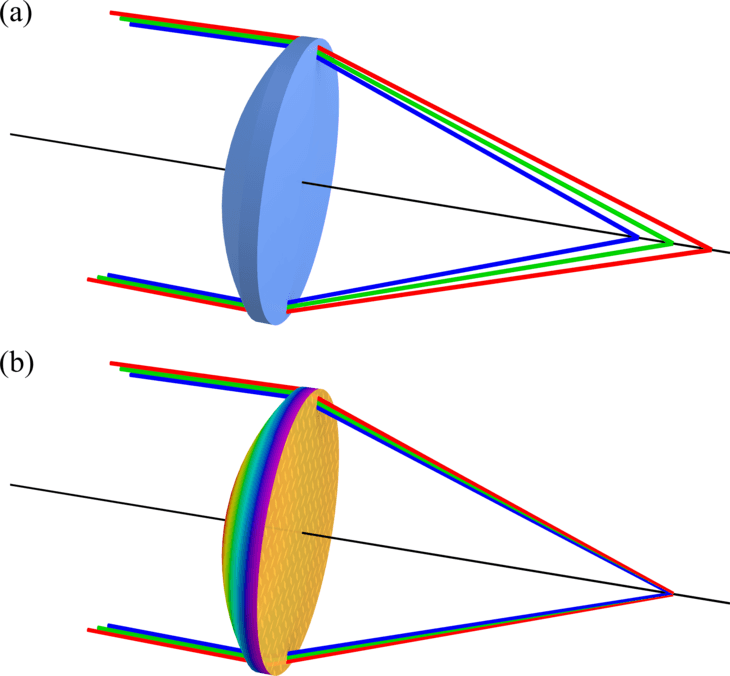Feb 14 2018
Multiple, heavy lenses are often required to produce the perfect color images which humans need and love, as these optical devices allow each color to focus on precisely the same plane.
 Traditional glass lenses (a) focus different colors to different points resulting in color separation and image blurring. In contrast, newly developed metasurface-augmented gradient-index lenses (b) correct for color separation by focusing blue, green, and red light to the same point. (Image credit: Jogender Nagar / Penn State)
Traditional glass lenses (a) focus different colors to different points resulting in color separation and image blurring. In contrast, newly developed metasurface-augmented gradient-index lenses (b) correct for color separation by focusing blue, green, and red light to the same point. (Image credit: Jogender Nagar / Penn State)
Now, engineers at Penn State have come up with a new theory that resolves this issue by using a single thin lens that contains metasurface layers and gradient index materials to direct the light in a precise way.
If we want high-performance optical systems, then we have to overcome material dispersion. If we don't, we get smeary colors, which significantly degrades image quality.
Sawyer D. Campbell, Assistant Research Professor in Electrical Engineering
Single apochromatic lenses can accurately focus the three colors such as blue, red, and green. These lenses are thinner, lighter, and have less curvature that could not only enhance cell phone cameras but also enable the development of thinner cell phones. Single apochromatic lenses could also be used for making lighter and better helmet cameras, body cameras, thermal imaging devices, sniper scopes, and drones or unmanned aerial vehicles. In fact, anything that employs lenses for imaging purposes could be made lighter and simpler.
Usually, there are several lenses, but that increases the weight. Our aim is to improve SWaP — reduce size and weight while increasing performance.
Jogender Nagar, Graduate Student in Electrical Engineering
The engineers thought to integrate two technologies: that of metasurfaces —ultra-thin optical layers with sub-wavelength features that control the wavefront in a preferred manner — and gradient-index (GRIN) lens. The researchers have reported the results of their study in the current issue of Optica.
"Our system uses one lens," said Nagar. "We use the curvature of the lens, the distribution of materials in the lens, and a metasurface — a pattern placed on the surface — to make the lens thinner, lighter, but still focus properly."
Curvature is used by most lenses to manipulate the focal point. However, three traditional lenses are required to focus the three separate colors to a single focal point and create a high-quality image. When the material composition of the lens is spatially changed, a single GRIN lens can accurately focus two colors. Subsequently, when a metasurface is added to the GRIN lens, a single-layered lens can accurately focus all the three colors, thus doing the work of three standard lenses.
"The gradient in the lens can be axial — varying along the direction of light propagation, or optical axis or radial — varying outwardly from the optical axis," said Douglas H. Werner, John L. and Genevieve H. McCain Chair Professor in electrical engineering. "Or it could be more complex."
To create these lenses, the team developed a simulation framework and theoretical model.
"We had to use some advanced tools that were specially developed in the lab," said Werner. "Tools for modeling, simulation and optimization that we created for solving such a challenging design problem."
The new theoretical model specifies the proper patterning for the metasurface and the proper gradient and surface curvature in the GRIN lens to fulfill the requirements of seamless focusing on all three individual colors. The theoretical model optimizes both the metasurface and the lens and to work together.
"The theory is very general and covers a wide range of conditions," said Werner. "Fabrication will be the challenge initially. We hope development of the theory will steer the fabrication, making it possible to produce such lenses at a low cost and high volume."
The work was supported by the Defense Advanced Research Projects Agency.